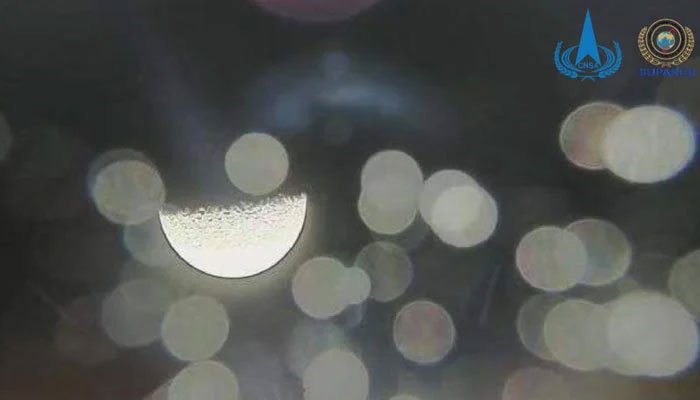iCube-Qamar beams back first image from moon’s orbit
"iCube-Qamar has made three rounds around the moon," says Institute of Space Technology
ISLAMABAD: Pakistan’s first satellite mission to the moon, iCube-Qamar, sent the first-ever image of the moon captured in the lunar orbit, the Institute of Space Technology told Geo News on Friday.
Earlier, the satellite transmitted an image from the lunar orbit. Making this a groundbreaking development, according to IST, Qamar is the first Pakistani satellite to enter the lunar orbit and completed its rotation in 12 hours.
“The iCube-Qamar will image the lunar orbit from a distance of 200 kilometres from the surface of the moon,” the IST said. It added that the signals of iCube-Qamar will be received on Earth by covering a distance of 360,000 to 400,000 km.
The first image was received two days after IST announced that the satellite was successfully deployed in orbit on May 8 at 1:14pm Pakistan time.
Meanwhile, the Chinese Embassy in Pakistan took to X, formerly Twitter, to congratulate Pakistan for the breakthrough.
“Well begun is half done. As Pakistan’s satellite ICUBE-Q successfully entered lunar orbit on Wed after 5 days of travelling, scientists received initial image data, laying solid foundation for in-depth [China-Pakistan] co-op in moon & deep space exploration,” the embassy wrote in a post.
The scientist termed the development “a great success overall”. Following its deployment, the satellite will take images of the desired lunar surfaces in a carefully selected 12-hour elliptical orbit. The iCube-Qamar was launched on board China’s Chang’e-6 from Hainan, China, on May 3. iCube-Qamar orbiter carries two optical cameras to image the lunar surface. Following successful qualification and testing, the orbiter was integrated with China’s Chang’e6 mission — the sixth in a series of lunar exploration missions.
-
May 22, 2020 air crash: PIA says implementing inquiry report recommendations
In February this year, an investigation into the air disaster by the Aircraft Accident Investigation Board determined...
-
Pakistan gets back stolen artefacts worth millions of dollars from US
United States returned the 133 pieces of stolen antiquities in the 5th such transfer to the country
-
Spending 67pc of railways budget on salary, pensions big challenge, Senate told
23.53pc of total budget for department was spent on running trains and 6.3pc and 3.65pc, respectively, on repair and...
-
Consumers foot the bill of grid constraints,violation of power plants merit order
Analysis of the dispatch summary revealed a significant disparity in power generation between the north and south...
-
Rear Admiral Amir appointed Addl Secy in MoD
He would replace Rear Admiral Khyber Zaman who has been relieved of his duties as Additional Secretary
-
2 doctors working for Unicef declared ‘persona non grata’
Khyber Pakhtunkhwa Health Department had formed the committee to probe irregularities
-
 Your Tampon Can Help Detect THIS Virus
Your Tampon Can Help Detect THIS Virus -
 Prince Harry Warned Against Hurting King Charles
Prince Harry Warned Against Hurting King Charles -
 Prince William, Kate Middleton Have Serious Fears Towards Prince Harry, Meghan Markle
Prince William, Kate Middleton Have Serious Fears Towards Prince Harry, Meghan Markle -
 Kate Middleton's Artist Gives Powerful Message After Backlash
Kate Middleton's Artist Gives Powerful Message After Backlash -
 Iran's Raisi Buried In Mashhad As Mourners Pack Iranian Holy City
Iran's Raisi Buried In Mashhad As Mourners Pack Iranian Holy City -
 Kate Middleton Not In Position To Make Big Decisions
Kate Middleton Not In Position To Make Big Decisions -
 Cassie Speaks Out For The First Time After Video Leak Of Diddy Abusing Her
Cassie Speaks Out For The First Time After Video Leak Of Diddy Abusing Her -
 Superior Courts Moved Against Pemra's ‘blanket Ban’ On Court Reporting
Superior Courts Moved Against Pemra's ‘blanket Ban’ On Court Reporting
